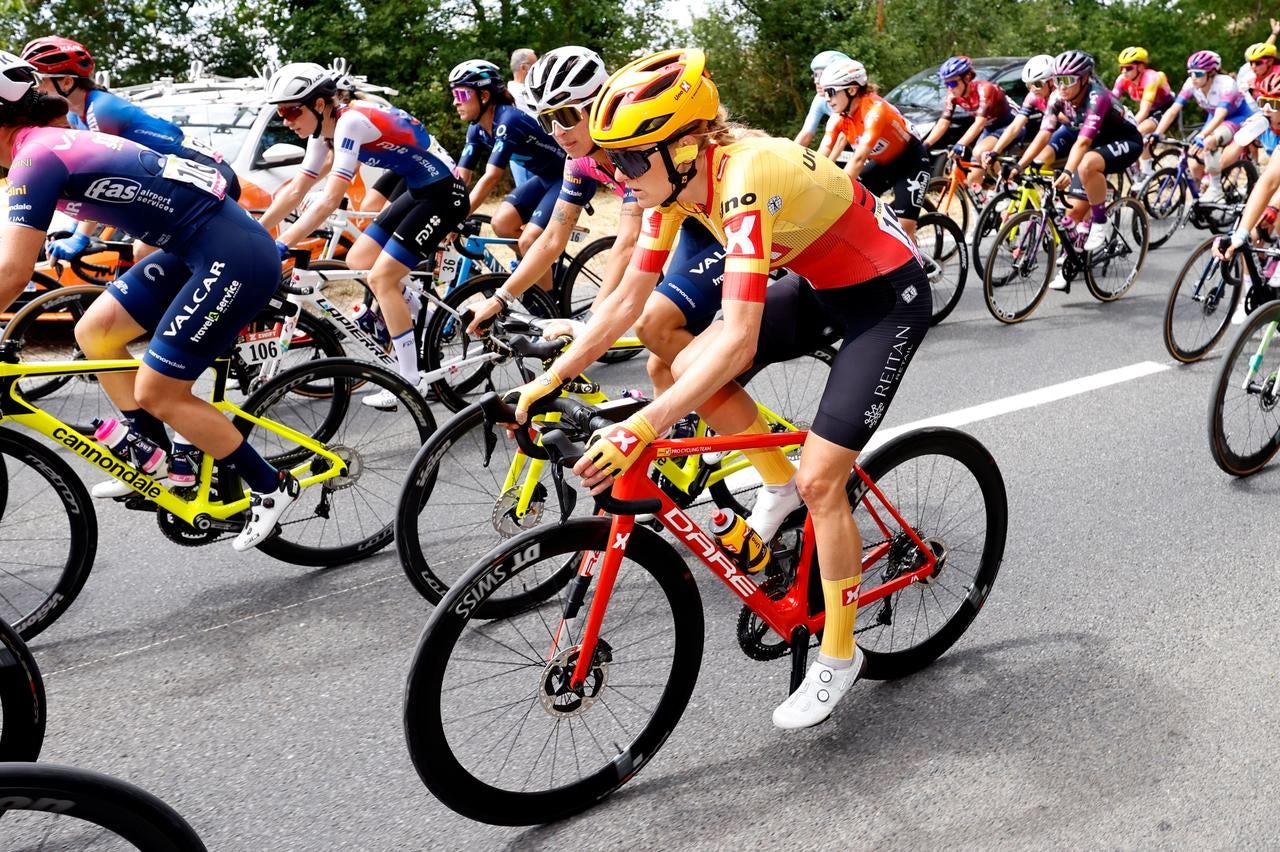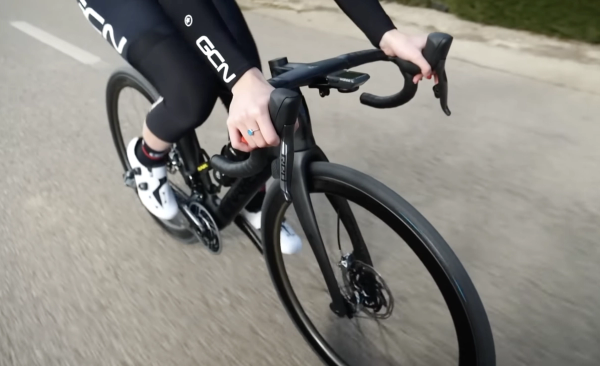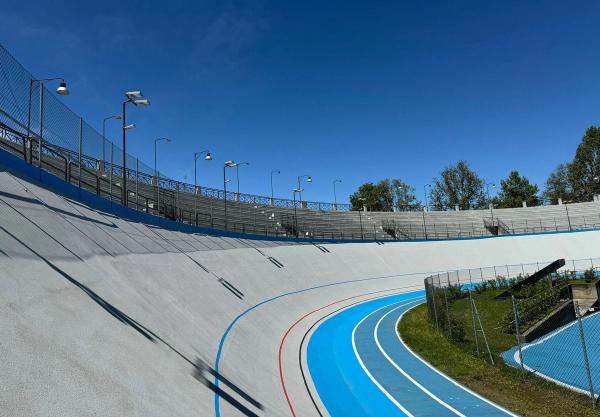Cycling through pregnancy: How Joss Lowden kept riding into the ninth month
Former Hour Record holder gives GCN an in-depth look into the physiological and psychological challenges of riding with a baby on board
Matilda Price
Racing News Editor
© Velo Collection (TDW) / Getty Images
Joss Lowden is the latest WorldTour pro to take time away from racing to have a child
For female cyclists, there are a whole host of physiological factors that can influence your riding or training, from a different anatomy and body composition, to hormone cycles and menstruation.
Perhaps the biggest change that a female rider can face, though, is pregnancy. Being pregnant will change your body, affect your fitness and require adaptations in everything from your nutrition to your sleep, but as plenty of riders are proving, it doesn’t have to stop you riding or training.
Even in 2023, the research and knowledge around exercising and training whilst pregnant is still a growing field, both for professional and amateur athletes. In cycling, a growing number of riders in the women’s peloton have navigated pregnancy in recent years, shedding light on both how to train whilst pregnant, and how to balance racing and motherhood once the baby has arrived.
Speaking to GCN just three weeks before the due date of her first child, Joss Lowden had just got back from a two-and-a-half-hour ride in Andorra. Tackling 1,332m of climbing and setting Strava segment PRs isn’t what you expect most women to be doing at eight months pregnant, but it seemed to be working for the 35-year-old Uno-X rider.
“Relatively, I’ve had it really easy,” Lowden said of the pregnancy that allowed her to ride and train right up to the final days before the birth of her son in June.
“I didn’t really get sick at the beginning. I felt a bit queasy sometimes, but generally if I went out for a bike ride or a hike or something I felt better. And then I’ve been able to carry on riding, training, hiking, swimming and gymming, and doing what I liked the whole time.”
For many women, pregnancy is just step one of motherhood, and it’s the reality of having a newborn that looms as the really big change, overshadowing the months before. But for athletes, the nine months of being pregnant is a huge challenge in itself, with the baby’s arrival almost a welcome relief from the physical test of pregnancy.
“People keep saying ‘oh my gosh, your life is about to change’, and I’m like, I’m kind of waiting for my life to go back to normal,” Lowden explained.
“It's been a really strange year, because your body's not your own. You're sharing it. You always have to think not just about the effect of what you're doing on yourself, but what it's doing to the little creature that you're growing as well.”
Understanding and accepting the changes to your body
Part of the reason the actual pregnancy is so challenging for athletes, Lowden said, is that suddenly, you have much less control over your body and your fitness. For modern athletes, able to track all aspects of their fitness, and carefully plan everything around their training, having to give that up can be daunting.
“Particularly as athletes, we're really used to being very, very in control of how we feel,” Lowden explained. “And so everything that we do, essentially, is geared towards performance and feeling good. You know that if you eat well, sleep well, train well, you go to bed early, you do all of these sorts of things, you will wake up the next day and more than likely feel good.
"And if you don't do those things, if you stay out late or whatever, then you won’t feel so good, and you won't be able to train. Apart from getting ill and whatever, it's quite systematic.
“But you have to completely relinquish that when you get pregnant because you can't really control the days where you feel good. And the days where you don't, it doesn't seem to make much difference what you do.”
Whilst feeling good can sometimes be an intangible thing, there are also plenty of marked, physical changes that female athletes go through. Like all pregnancies, these will differ from person to person, but Lowden explained some of her experiences. As well as the expected things like gaining weight and slowing down on the bike, there were less obvious things that impacted Lowden’s fitness.
“Within literally a few weeks of being pregnant, my resting heart rate had gone from 38 to 65 [bpm], in like two weeks. Then I’d go to get on the turbo, and I think I was doing 107 watts and my heart rate was at like 160, which is really high for like, nothing. Just going nuts.
“So that’s really difficult to get your head around because you think ‘I can’t control this, I can’t do anything about it’ but then you have to think ‘but I’m growing a human being. That’s really amazing.’”
Pregnant cyclists can still do a lot of riding
As well as experiencing all the physical changes and how that affects riding, pregnant cyclists may wonder how much riding they should or shouldn’t do. Unfortunately, there isn’t one single answer to the question of ‘how much should a pregnant cyclist ride’, and even the pros have different approaches.
For Lowden, the answer to the question of quantity is quite a lot, and probably more than most pros who have trained through pregnancy. Lowden took on mountainous riders that would scare off most amateurs, and clocked up the kilometres until right before her baby’s arrival.
The amount of climbing, Lowden explained, was partly an unavoidable fact of living in Andorra, but it also came down to the simple fact that she was able to and wanted to keep riding so much, which is perhaps the easiest place to draw the line around possibilities and limitations.
“I think it’s about understanding your own body. There are things that I was comfortable doing that wouldn’t necessarily mean that everybody would be comfortable doing in training. You kind of get to learn how hard you can push your body, and everyone has different limits of how far they want to take it.”
So, how much should an amateur rider expect to ride? Much like the pros, the answer is that it depends - there is no prescribed distance, and it depends on a lot of things, not least what you want to do. While we don’t all have the capabilities of WorldTour professionals, the likes of Lowden and others have shown that there isn’t an upper limit on what is possible; if you’re able, comfortable and want to keep doing solid rides, pregnancy doesn’t need to stop you.
Nutrition and fuel
The other thing that is a big consideration for cyclists, and will change a lot in pregnancy, is nutrition. As Lowden explained, this is another element of the giving up control that riders have to do in pregnancy. In normal times, a cyclist can plan their nutrition carefully, and many are very particular about what and how much they eat, but that can be less predictable when you’re supporting a growing baby as well as yourself.
For Lowden, she explained that, because her training load went down as her energy demands from pregnancy went up, there was not a big change in the amount she ate - she fuelled like she was still training at full capacity, but rode less, and things balanced out - but there were still things to be aware of, both during and after pregnancy.
“You definitely have to be conscious of eating plenty when you’re riding,” she said. “I try to really not go for any periods where I’m hungry, but I didn’t really like to do that too much anyway. It’s just being on top of it, making sure you get all of the essential energy and nutrients that you need.
“The other thing you have to be really careful of is that if you’re breastfeeding, that’s when you need to keep having a really large number of calories coming in. Especially when you’re training, you go out and ride, and you can take in 2,000, 3,000 calories and essentially still be in a deficit, so that’s a lot of food that you need to maintain that sort of milk supply.
“So I think it’s getting into the mindset that you don’t want to just give birth and go ‘right, I’m on a diet, I’m going to lose all this weight’ - your body is still sustaining the growing life of your baby, and that’s the priority.”
With the changes in training and eating - and, of course, the fact of being pregnant - also comes a lot of changes to one’s body, and for athletes, where weight and body image can often be complicated issues, this can be another challenge to contend with.
“You start storing fat and holding onto a lot of liquid [in the early stages] so that was quite difficult because you really notice the changes to your body. And as an athlete, you’re used to being in a particular type of body, but you do stop caring after a while.”
Letting go of that control can be hard, but for Lowden, it’s just about knowing that your body is doing the right thing.
“You have to trust your body to know what to do,” she said. “If I wasn’t putting on weight and I carried on being really thin, I think that would be more disconcerting, so I’m like ‘yeah, your body knows what it’s doing here, let it do its thing’.’”
The importance of shared knowledge
Like for most elements of cycling - training, nutrition, recovery - Lowden turned to research to try to understand what coaching professionals, physiologists and other athletes knew about riding during pregnancy. The problem was, there was very little to be found.
“We went on this journey to understand more. We listened to a lot of podcasts, we researched a lot,” she explained.
“But there is actually such a small amount of research on what you can do in terms of athletic performance and the impact it has on the baby. So there’s not a huge amount, but there is quite a lot of research, or definitely anecdotal evidence - papers that have been shared and podcasts from runners, so I did a lot of listening to runners.
“You see some of these incredible ultra-endurance that have continued racing long into their pregnancy, and returned pretty soon postpartum as well. So we did quite a lot of research there.”
Given the research and guidance around sport and exercise through pregnancy is still a nascent field, one thing that has helped a lot of the pregnant riders in the peloton is the shared knowledge from other parents. For Lowden in particular, she had the benefit of not only the women in the peloton who had experienced this already, but a teammate in the form of Elinor Barker.
“I think having Elinor on my team and having access to her TrainingPeaks [was useful], and her coach was really helpful and he chatted with my coach,” Lowden said.
Barker had her first child in 2022, and came back to racing for Uno-X - who had signed her whilst she was pregnant - that year, and has since developed into perhaps the best road form of her career in 2023. Though there are other mothers in the peloton, like Lizzie Deignan and Marta Bastianelli, having Barker as a teammate gave Lowden and her team a better understanding of the journey.
Some of this has been in the form of specific advice - Lowden mentioned various things Barker had told her about training, coming back to riding, breastfeeding and more - but there’s also just the sense of a shared experience, and knowing others have done it before.
“There’s so much more information now and people are really sharing more. Within my team, we’re gathering good data on training, training through pregnancy, and the return to racing as well. It’s really, really useful. Everybody is different, everybody’s response is different, but just knowing what’s been experienced before, what to expect and how to prepare yourself is really helpful.”
Joss Lowden’s expert advice for pregnant cyclists
With everything from the physical changes and demands of pregnancy to the mental challenges of how you approach all that, there is a lot for pregnant women to contend with. We may not all be professional athletes, but there are things that every cyclist, of any level, can learn from the women who have done it at the very top level of the sport. Here are Lowden’s key bits of advice for cyclists who are pregnant.
It’s not the same for non-pros
The first thing Lowden is keen to point out before she offers any kind of advice is that she knows that her experience is different to most.
“It’s tricky because I know some people get extremely tired and can feel really ill, and you can say ‘oh but you’ll feel better if you ride your bike’ and it’s like well I did, most of the time, but I didn’t always. And the other thing is that I have all day, I’m paid to ride my bike, I have all day to fit in a ride and the gym and things like that - it’s not the same as fitting it into a busy work schedule.”
Keeping consistent helps
Even if comparing yourself to the pros isn’t useful, there is some advice that all pregnant cyclists - or any woman who exercises - can heed from Lowden.
“I do think if you can continue throughout maintaining some form of riding, training, activity or gym work, if you keep doing it, that’s why I can still do it at eight and a half months pregnant, because I’ve done it the whole time. It’s not like I stopped and then picked it up again. So some level of maintaining what you were doing before is good.”
The benefits are mental as well as physical
Exercise is often heavily linked with the physical, but as Lowden explains, keeping active through pregnancy can be just as important for your mental wellbeing, even as your physical performance changes.
“Mentally, because it’s the stuff you enjoy doing, it makes you feel good. There were days where I’d just be like ‘I’m so tired, I don’t want to do anything’ and then I’d get on the turbo and just do something. Sometimes it feels like you’re barely doing anything, but then afterwards the feeling that you’ve done it is so good, it is worth it.”
Lowden's final, but perhaps most important piece of advice? "Don't stop just because you're pregnant."








.jpeg?w=600&auto=format)



